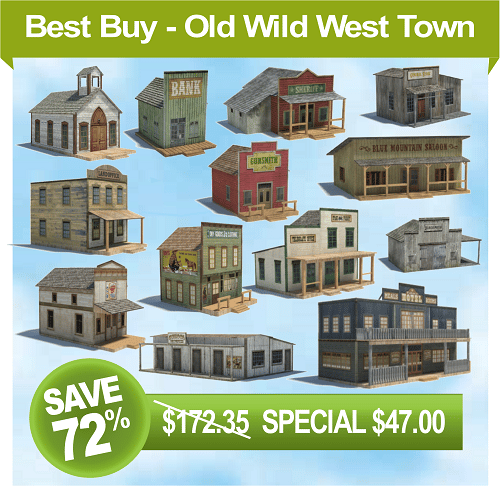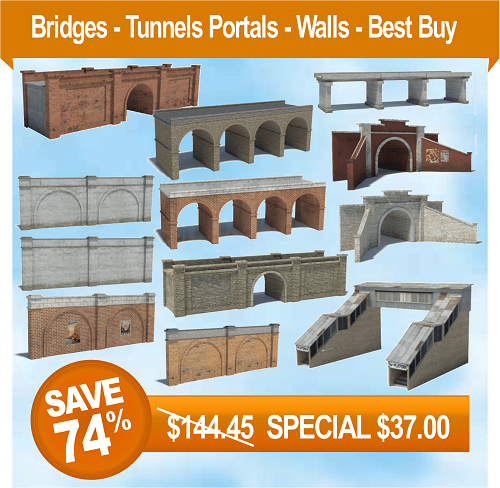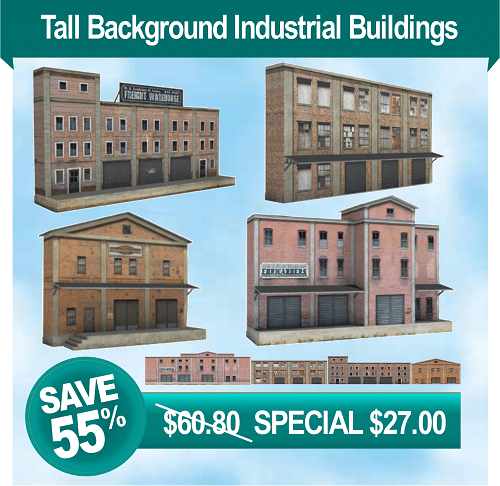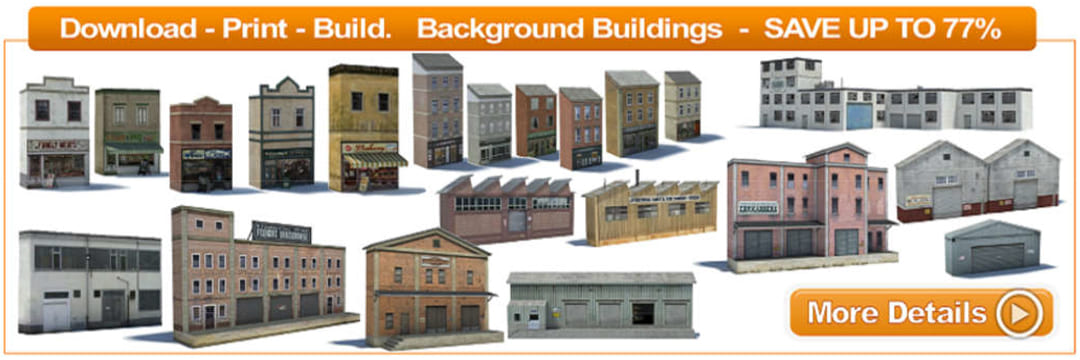Realistic Miniature Buildings Made to
OO, HO, or N Scale Can Really Bring a Scaled-
Down World to Life – Here’s How
To look authentic, a railroad must serve a purpose be it to transport freight or passengers, to serve a manufacturing plant or industry, a farming community, or possibly a coal mine, or old wild west town. The N scale buildings positioned on the layout need to look authentic and as though they belong in the railroad scene. The structures also need to be accurate in size (N scale, HO scale, OO gauge) depending on the scale of the trains being operated.
Most model railroaders begin in the hobby by building a bench with track and controls to operate their train or trains. Constructing scenery and landscaping is usually next on the list of tasks to work on. That is the time when a bench with some track and trains transforms it from a toy on a board to scaled-down world complete with terrain, foliage, roads, and miniature buildings.
Rock. Water. Grass. Under the layout there is…wood, foam board, more wood. The modeler’s job is to fool the observer into believing that the wood and foam are actually rock, water, dirt, grass, trees, and streets. Obviously once the structures like bridges and miniature buildings as well as people, animals, model trains and track are positioned in place the model railroad scene will come to life.
Start the scenery making process by shaping the ground of the miniature world of the railroad. This is done by carving foam shapes and creating new shapes from ordinary materials like cardboard, newspapers, masking tape, paper towels, plaster. There isn’t enough room here a complete description of all the techniques to make topography, but a bit of advice is to try out some skills on a part of the layout you can easily change if you aren’t successful, or to cut a small square (one to two feet square will do) of cardboard or scrap foam and use that to create a hill or valley or small mountain or river bed. Use several techniques from your reading and research and try them all on small sections of the test square. The miniature buildings for sale on this website will complete the realism when it is time to the finishing touches to the model railroad layout. The plans are quick and easy to download.
Try to create as much realism as you can on that tiny piece of model earth. Read up on how to cast a rock mold (really simple), and paste it with Sculptamold (a product that sculptors use to create objects) as an outcropping on your model hill. Then paint and weather it with washes and dry brushing. Remember, the plans for the miniature buildings for sale from this site will not require any weathering or detailing, because that task is already taken care of in the plan designs.
When creating the scene discard what looks inaccurate, keep what looks great, and keep looking for more ways to do it better. At some point in trying your skills out on the test square, you will discover a way that looks really great and you can apply that technique to getting started on your big model railroad layout. Many railroaders construct their layout in modules and add the structures and miniature buildings only when they have completed making all their modules. It is a personal choice.
In the early stages, carving and plaster molding will be a focus. Once you are satisfied with the method to create the shapes, coloring, washes, paint, and chalks will give you the tones appropriate to the part of the country you are modeling. Look for pictures of that area in any publication and try to duplicate what you see. If you are modeling a place nearby your home, you can visit, take samples of dirt and rock, and take lots of photos for reference. It is also important to select model trains, diecast cars, and miniature buildings designed to fit the era being modeled.
The Wonder of Trash
Model railroads need trash like flowers need rain. Model trash, that is. When was the last time you saw a railroad line run through an upscale neighborhood? Railroads love cheap right of way and hate lawsuits, and that’s why you see them running through the seediest part of most towns and cities. This is of great advantage to the modeler because disarray and chaos is not only dramatic, it’s fun to model. A stack of discarded railroad ties or pipes are ridiculously easy to create to any scale especially to OO, HO scale, and N scale. Some scraps of strip wood become ties, plastic coffee stirrers and soda straws painted dirty brown become piles of rusting pipe. This website even has a range of derelict abandoned miniature buildings to down, print, build, and position against the backgrounds of model railroads.
Discarded pieces of old model airplanes, ships, almost anything can be dressed down to be junk. Weeds made from short pieces of hemp rope or jute twine dyed brown or pale green can grow in clumps from piles of whatever you can find that’s shaped like small square boxes and cylinders.
The back or side of old miniature buildings have barrels of discarded items to model, and there’s plenty of plastic building shapes available to cut up and make in to refuse.
Weathering Model Cars, Trains, and Miniature Buildings
It’s fun to open the package from your favorite mail order house or model train store and admire that brand-spanking new and shiny locomotive, car, or miniature building. It’s fun for real railroad moguls to take delivery of brand new equipment, too! However, unless they plan to hide it in a storage building and never make use of it, one fact is universally true. Objects in the real world get DIRTY. Dirt, grime, wear, and tear are the mortal enemies of new and clean, and there’s absolutely no defense from them. Car washes and repair shops stay in business largely because of wear and weathering, and no retail business could really exist without recurring demand for products that wear out and break. Fortunately, plans for the miniature buildings available here are all pre-weathered and detailed, so that will save time and money. The downloaded plans for each structure and building comes in simple PDF format for easy downloading and printing on a home printer.
If your layout is replete with shiny new equipment, shiny plastic buildings, and accessories, it will look like a toy train set. If that’s the look you are going for, by all means, enjoy it! On the other hand, most modelers are sticklers for realism, and nothing says real like fading and dilapidation. If you are fortunate enough to live near a place of rail activity, spend a couple hours and look critically at the trains and surroundings. They are filthy! Oil streaks and grease smears, dirt, dust, rust, graffiti all show that every piece of equipment is being used, and used hard. Miniature buildings have fading paint and disrepair, roof shingles are missing and vents are rusting. Oil stains cover the ground, killing the vegetation.
This is a wonderful opportunity for the modeler to create drama on the layout. The techniques are about the easiest thing in modeling to do as well. Most weathering on model railroad layouts is done with a combination of washes, which are basically diluted paint, chalk, or muddy and grimy paint colors. Greys, browns, and blacks are nature’s paintbrush colors.




